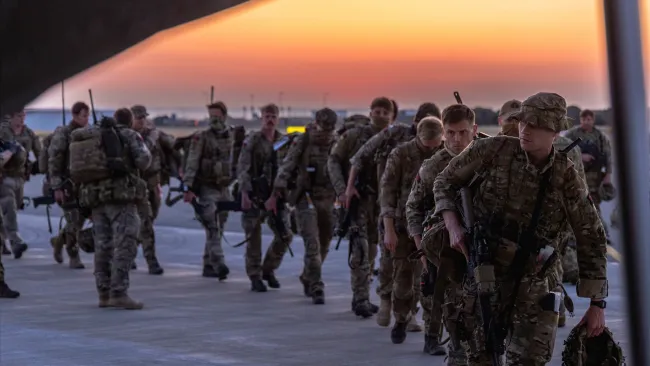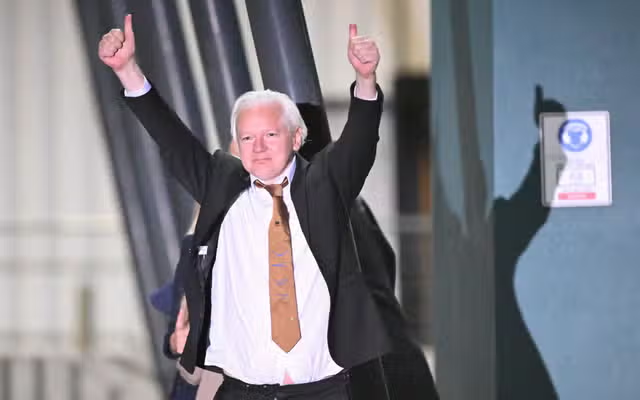The Central Asian country of Kyrgyzstan has been inundated with imported goods, including many from Europe, since Russia's invasion of Ukraine, prompting experts to question the international community's commitment to its sanctions regimes.
Responding to the February 22 invasion, the European Union, United States, and others hit Moscow with sweeping sanctions targeting financial services and energy exports, along with restrictions on trade and technology vital to Russia's defense industry's dual-use technologies critical for military purposes.
These sanctions have been regularly tightened, with the aim of hobbling Russia's economic and military capacity, but businesses are taking advantage of illicit trade hubs that have emerged in countries like Kyrgyzstan.
Kyrgyzstan-bound exports from Eastern Europe took off just after the February 2022 invasion, according to the International Monetary Fund (IMF) and national statistics represented by graphs by the Washington, D.C.-based Brookings Institution.
Robin Brooks, a senior fellow with the think tank, wrote: "We've flagged a massive spike in exports from Serbia to Kyrgyzstan, Similar spikes are happening across all of Eastern Europe: Romania, Bulgaria, and Hungary. None of this stuff obviously goes to Kyrgyzstan. It goes to Russia..." he wrote on X (formerly Twitter).
Export values with Kyrgyzstan are shown to have gone from around $1 million per month for Hungary and less than $1 million in the case of the other three countries to over $4 million (Romania), $4.5 million (Bulgaria), approximately $9 million (Hungary), and over $30 million (Serbia).
Another series of charts released by the Brookings Institution last week illustrated Central and Western European countries soaring exports to the former Soviet-bloc state over the past couple of years.
Germany's export value rose from less than $10 million in March 2022 to reach around $80 million before dipping to under $70 million in July. Italian and Austrian exports went from around $1 million or less to nearly $40 million and $8 million, respectively.
Poland's export value soared from no more than a few million to around $50 million in 2023. However, the chart then shows a steep decline this year, with Poland officially only exporting $20 million to Kyrgyzstan in July.
"Are we seriously to believe that nothing can be done to stop the shameful flood of transshipments to Russia via Central Asia? Come on. This is just about a lack of political will," Brooks wrote in an X post.
Peter Stano, an EU spokesperson for foreign affairs and security policy, called stamping out sanctions workarounds "a top priority."
"We are stepping up efforts to ensure that sanctioned EU goods, in particular those used in the Russian military systems, do not find their way to Russia via third states," he told Newsweek.
In addition to cracking down on efforts to dodge the EU's trade embargo on Russia, the 27-member bloc has stepped up diplomatic engagement with platform countries, or potential hubs where exporters can circumvent the trade embargoes, with EU special sanctions envoy David O'Sullivan "in constant contact" with governments of countries at "high risk" off circumvention, including in Central Asia.
"We appreciate the openness of Central Asian countries to cooperate with the EU on this important issue and we see promising results stemming from reinforced export control measures, which resulted in encouraging trade statistics with direct exports of priority goods to Russia dropping significantly," O'Sullivan went on, but acknowledged there was more work to be done in these at "high-risk" areas.
He said the EU was "working closely" with the U.S. and U.K. to "stop the reexport of sensitive items to Russia with a special focus on the EU's Common High Priority Goods list of products such as advanced electronics, precision tools, and integrated circuits that could support Moscow's wartime industrial base.
In March, the IMF's Middle East and Central Asia Department reported on Kyrgyzstan's markedly changed trade dynamics.
Officially, the country's exports had fallen by 18 percent since 2021, the year before Russian President Vladimir Putin launched the invasion, while imports soared by 76 percent, "making the economy overall significantly more dependent on external trade."
Two countries, Russia and China, account for increasingly large shares of Kyrgyzstan's trade.
In terms of imports, China's share rose from 26 percent in 2021 to nearly 42 percent the following year. Meanwhile, goods shipped to Russia more than tripled from just 14.3 percent of Kyrgyzstan's total exports to 48 percent.
The Polish, Austrian, German, and Italian Trade Ministries; U.S. Treasury, and the Russian Ministry of Economic Development did not immediately respond to written requests for comment.
Disclaimer: The copyright of this article belongs to the original author. Reposting this article is solely for the purpose of information dissemination and does not constitute any investment advice. If there is any infringement, please contact us immediately. We will make corrections or deletions as necessary. Thank you.




